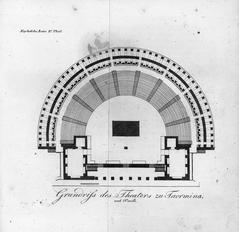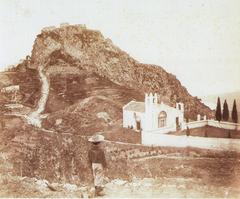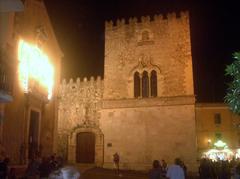
Capo Taormina Visiting Hours, Tickets, and Travel Guide
Updated: 14/06/2025
Introduction to Capo Taormina and Its Historical Significance
Capo Taormina, set against the dazzling backdrop of Sicily’s eastern coastline, is a destination where history, natural beauty, and vibrant culture converge. Overlooking the sparkling Ionian Sea, this scenic promontory has witnessed the ebb and flow of civilizations—from Greek colonists who established ancient Tauromenion (modern Taormina) in the 4th century BCE, to Roman, Byzantine, Arab, Norman, and Spanish rulers, each leaving their mark on its landscape and heritage (TravelTaormina.com; The Italy Edit). Today, Capo Taormina enchants visitors with dramatic cliffs, crystalline waters, and iconic sites like the Ancient Greek Theatre, offering breathtaking vistas of Mount Etna and the Sicilian coastline (italyguides.it; Dive Sicily).
Nature lovers and history enthusiasts will find much to explore: sea caves, pebble beaches, and the protected Isola Bella nature reserve, which sustains a rich marine and terrestrial ecosystem (Tourist Secrets). This comprehensive guide delivers all you need to plan your visit—covering practical details on visiting hours, tickets, accessibility, transportation, and highlights of local festivals, cuisine, and nearby attractions. With expert tips and digital resources like the Audiala app, your journey to Capo Taormina and Taormina promises to be seamless and memorable (CN Traveller; alluringitaly.com).
Table of Contents
- Introduction to Capo Taormina
- Historical Evolution & Cultural Significance
- Visiting Capo Taormina: Practical Information
- Architectural and Natural Heritage
- Notable Events & Cultural Highlights
- Geographical Setting & Landscape
- Natural Attractions & Points of Interest
- Climate & Environmental Conditions
- Visitor Experience: Activities, Safety, and Tips
- Taormina Historical Sites: Visiting Hours & Tickets
- Festivals, Local Traditions, and Culinary Culture
- Practical Visitor Tips & FAQs
- Conclusion & Final Tips
- References
Historical Evolution & Cultural Significance
Ancient Origins and Early Settlement
Capo Taormina’s story begins with Greek settlers from Naxos, who, after their city’s destruction, founded Tauromenion atop Monte Tauro in the 4th century BCE. The promontory’s strategic location provided commanding views over the Ionian Sea, making it a key outpost for defense and trade (TravelTaormina.com).
Roman, Byzantine, Arab, Norman, and Spanish Eras
As Taormina came under Roman rule from 212 BCE, Capo Taormina’s role as a defensive and maritime hub grew. The Byzantines later fortified its cliffs and caves against invaders, while the Arab conquest in the 9th century introduced new agricultural and cultural practices. The Normans and, later, the Spanish continued to reinforce and shape the area (The Italy Edit; TravelTaormina.com).
Modern Era
In the 19th century, Capo Taormina became a magnet for artists and writers—D.H. Lawrence among them—helping Taormina emerge as a stop on the European Grand Tour. Today, its beaches and coves are popular for recreation, while the proximity of Isola Bella adds further allure (CN Traveller).
Visiting Capo Taormina: Practical Information
Visiting Hours
- Outdoor Areas & Beaches: Open year-round, typically from sunrise to sunset.
- Ancient Greek Theatre: Open daily, generally 9:00 AM–7:00 PM (hours vary seasonally).
Tickets & Entry
- Capo Taormina Promontory & Beaches: Free access.
- Ancient Greek Theatre: €10–€15 for adults, reduced prices for students and seniors. Tickets can be purchased online or on-site.
Accessibility
- Some beaches and viewpoints are accessible for those with mobility challenges, though the natural terrain is steep and rocky.
- The Ancient Greek Theatre provides limited wheelchair access; check details before your visit.
Getting There & Transportation
- From Taormina Center: Short walk or quick taxi ride.
- By Public Transport: Trains and buses connect to Taormina from Catania and Messina. Parking is available near Corso Umberto I.
- Guided Tours: Combine Capo Taormina with other attractions for a structured experience.
Best Time to Visit
- Spring (April–June) and Early Autumn (September–October): Pleasant weather, manageable crowds.
- Summer (July–August): Hot, busiest period.
Special Events
- Open-air concerts and cultural events, especially during the Taormina Film Fest, often utilize the natural amphitheater of Capo Taormina (TravelTaormina.com).
Architectural and Natural Heritage
Capo Taormina’s cliffs, sea caves, and clear waters are complemented by Taormina’s architectural marvels. The Ancient Greek Theatre, carved into the hillside, creates a unique blend of nature and history, while streets like Corso Umberto I showcase medieval and baroque buildings (The Italy Edit; TravelTaormina.com).
Notable Events & Cultural Highlights
- Historic Naval Engagements: The promontory played a role in ancient and medieval military history.
- Modern Tourism: Today, Capo Taormina is a cultural hub, hosting festivals and drawing artists and travelers from around the world.
Geographical Setting & Landscape
Location and Topography
Situated just south of Capo Sant’Andrea and within Taormina’s municipality, Capo Taormina juts into the Ionian Sea, dividing Taormina’s bays from the waters surrounding Isola Bella (Dive Sicily). The promontory’s rocky cliffs and geological features are shaped by tectonic and volcanic activity, with views reaching as far as Mount Etna (Savoring Italy).
Coastal and Marine Environment
The coastline features pebble beaches, small coves, and turquoise waters, adjacent to the protected Isola Bella Nature Reserve. The marine ecosystem is home to moray eels, octopus, and diverse fish species (Tourist Secrets).
Panoramic Views
Capo Taormina offers sweeping views of the Ionian coastline and Mount Etna—sunrise and sunset are especially magical (Italia.it).
Natural Attractions & Points of Interest
Isola Bella
A tiny island connected by a sandbar, Isola Bella is a nature reserve with lush vegetation and clear waters, ideal for snorkeling and swimming (Tourist Secrets).
Grotta Azzurra & Sea Caves
Accessible by boat or kayak, the Grotta Azzurra and other caves are famed for their blue waters, ideal for exploration (Dive Sicily).
Underwater Reefs & Dive Sites
Capo Taormina is a premier spot for diving and snorkeling, with exceptional visibility and rich marine life (Dive Sicily).
Flora & Fauna
The area’s Mediterranean scrub supports a range of bird species and marine habitats, including seagrass meadows and protected fish (Tourist Secrets).
Climate & Environmental Conditions
- Mediterranean Climate: Hot, dry summers (25–32°C) and mild winters (rarely below 10°C), with over 2,500 hours of sunshine annually (Italia.it).
- Environmental Protection: Isola Bella and surrounding marine areas are protected; visitors should avoid disturbing wildlife and refrain from collecting natural materials (Tourist Secrets).
Visitor Experience: Activities, Safety, and Tips
- Swimming & Sunbathing: Safe, scenic pebble beaches and coves.
- Snorkeling & Diving: Explore vibrant reefs; guided dives recommended (Dive Sicily).
- Boating & Kayaking: Rent boats or kayaks to visit caves and Isola Bella.
- Hiking & Nature Walks: Coastal trails offer stunning views and birdwatching.
- Safety: Use caution on rocks and be mindful of currents and weather.
- Best Time to Visit: May–October; shoulder seasons (May–June, September–October) offer fewer crowds (Eternal Arrival).
Taormina Historical Sites: Visiting Hours & Tickets
Ancient Greek Theatre (Teatro Antico di Taormina)
- Hours: 9:00 AM–7:00 PM daily; last entry one hour before closing.
- Tickets: ~€10 for adults, reduced rates for EU youth, free for children under 18. Free entry on the first Sunday of each month (italyguides.it).
- Events: Hosts concerts and the Taormina FilmFest (taormina.it).
Other Notable Sites
- Palazzo Corvaja: Open Monday–Saturday, 9:00 AM–1:00 PM.
- Odeon & Duomo di Taormina: Hours vary; check locally.
Festivals, Local Traditions, and Culinary Culture
- Taormina FilmFest: Annual June cinema festival in the Ancient Theatre.
- Taobuk – International Book Festival: Literary events in June (taormina.it).
- Sicilian Folk Festival: Local music and dance in May.
- Culinary Delights: Try arancini, caponata, fresh seafood, and cannoli in family-run trattorias (sicily-adventure.it).
- Nightlife: Enjoy wine bars, concerts, and the evening social scene along Corso Umberto I (saltinourhair.com).
Practical Visitor Tips & FAQs
Q: Are there entrance fees for Capo Taormina or Isola Bella?
A: Capo Taormina access is generally free; Isola Bella Nature Reserve charges a small fee during peak season.
Q: What are the exact visiting hours?
A: Capo Taormina: sunrise to sunset; Ancient Greek Theatre: 9:00 AM–7:00 PM (seasonal variations possible).
Q: Are guided tours available?
A: Yes, for historical and natural highlights.
Q: Is Capo Taormina wheelchair accessible?
A: Some accessible paths exist, but terrain can be challenging.
Q: How do I get there from Taormina?
A: On foot, by car, taxi, bus, or boat from Giardini Naxos.
Q: When is the best time to visit?
A: Late spring to early autumn (May–October), with May–June and September–October being ideal for fewer crowds.
Q: Are there free entrance days for major sites?
A: Yes, the first Sunday of the month for the Ancient Greek Theatre.
Conclusion & Final Tips
Capo Taormina and Taormina together form a captivating destination blending history, culture, and natural splendor. From the Ancient Greek Theatre’s panoramic views to the tranquil waters of Isola Bella, visitors can enjoy both exploration and relaxation. Plan ahead, check visiting hours and ticketing, and consider guided tours for a richer experience. Use the Audiala app for up-to-date information and personalized tips, and follow our channels for the latest updates.
For more information, visit:
TravelTaormina.com
Dive Sicily
explorecity.life
italyguides.it
The Italy Edit
CN Traveller
alluringitaly.com
Top Secret Sicily
Tourist Secrets
Italia.it



